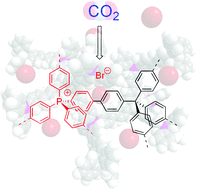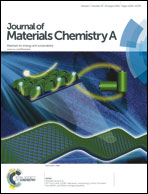Cationic microporous polymer networks by polymerisation of weakly coordinating cations with CO2-storage ability†
Abstract
Microporous organic polymer networks with weakly coordinating cations in their backbone have been synthesised by metal catalysed C–C bond forming reactions. A functionalised tetraphenylphosphonium ion was synthesised and successfully used as a tecton in a co-polymerisation with tetrakis(4-bromophenyl) methane using nickel catalysed Yamamoto coupling and with triethynylbenzene in a palladium catalysed Songashira–Hagihara reaction. The microporous materials showed an apparent BET surface area of 1455 m2 g−1 and 540 m2 g−1, respectively. The Yamamoto product provide a CO2 uptake of 2.49 mmol g−1 at 273 K and 1 bar. After ion exchange with chloride CO2 uptake is further increased to 2.85 mmol g−1.


 Please wait while we load your content...
Please wait while we load your content...